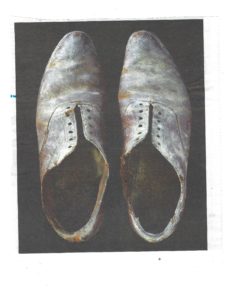Article by Murray Ellison
In a previous 2/15/2016 blog, I wrote about the importance of starter lines to engage readers and draw them into the images of a poem. Shakespeare offers an interesting opening statement in Sonnet 116, “Let me not to the marriage of true minds /Admit impediments.” However, his final two “Twist” lines are certainly among the most intriguing ones in poetry. He proclaims that if the he is wrong in the conclusions of sonnet 116, then “I never writ, nor no man ever loved.” Although there has been much speculation that Shakespeare did not write all of the poetry attributed to him, no scholar would ever be foolish enough to argue that he never wrote any of the works that bear his name. Even if he never did write a word of poetry or drama, it would even be more absurd to conclude that “no man ever loved.”
Sonnet 116
(“The Marriage of True Minds”)
By William Shakespeare
Let me not to the marriage of true minds
Admit impediments. Love is not love
Which alters when it alteration finds,
Or bends with the remover to remove.
O no, it is an ever-fixèd mark
That looks on tempests and is never shaken;
It is the star to every wand’ring bark,
Whose worth’s unknown, although his height be taken.
Love’s not Time’s fool, though rosy lips and cheeks
Within his bending sickle’s compass come;
Love alters not with his brief hours and weeks,
But bears it out even to the edge of doom.
If this be error and upon me proved,
I never writ, nor no man ever loved.
What does Shakespeare write about in Sonnet 116 which makes him offer such a strong disclaimer at the end? He advances the idea that he is not opposed to “marriage” for couples who are of “true minds.” This line reminds us of the words recited by a marriage officiator who asks, “Does anyone have a reason that this couple before you should not be married? Shakespeare uses much of the rest of the sonnet defining “true minds” and defending his proclamation. “True love’ would never be altered when circumstances change, or even when one of the two lovers has been unfaithful. Rather, a true love is constant like the navigational star, Polaris. It remains fixed as ships (metaphors for couples) sail through turbulent seas.

The value of such a rare love cannot be calculated. It increases even when the sickle of “Time’s fool” cuts into a lover’s physical beauty. It endures even when the grim reaper comes calling “to the edge of doom.” Shakespeare is confident that he will not be proven wrong when he states, “If this be error and upon me proved, I never writ, nor no man ever loved.” The theme of this poem echoes that of his Sonnet 18, “Shall I Compare Thee to a Summer Day.” In 18, the object of Shakespeare’s love is not specifically defined, although I assume that he is considering that his writing will be valued and loved forever.
After an early reading of Sonnet 116, it appears that Shakespeare’s poem is mainly about romantic love because he mentions marriage in the first line. However, he keeps the object of his love open again to question when he pairs the obvious certainties of his writing with another obvious conclusion, that most men and women have loved. Today, we probably know few people who have such an enduring love. Probably even Shakespeare did not know many couples who met his high standards. His poem, then, may also be alluding to the conclusion that though everyone dies, his poetry will even be more powerful than romantic love because it will never die or be proven wrong. With this line of thinking his “marriage of true minds” could mean that those who appreciate rare treasures will always value his writing. I doubt that Shakespeare will be proven wrong if that is his claim!
##################################################################################
Murray Ellison received an M.A. in Education from Temple University (1973), an M.A. in English Literature from Virginia Commonwealth University (2015) and a Doctorate in Education from Virginia Tech in 1987. He is married and has three adult employed daughters. He retired as the Virginia Director of Community Corrections for the Department of Correctional Education in 2009. Currently, he serves as a literature teacher, board member, and curriculum advisor for the Lifelong Learning Institute in Chesterfield, Virginia. He is the Chief Editor of www.LitChatte.com, an editor for the “Correctional Education Magazine,” and editing a book of poetry written by an Indian mystic. He also serves as a board member and volunteer tour guide at the Edgar Allan Poe Museum in Richmond Virginia. You can write to Murray by leaving a Comment on this Blog, or at ellisonms2@vcu.edu. You can also receive automatic postings from www.Litchatte.com by submitting your email address on the dialogue tab to the right of this Blog.




